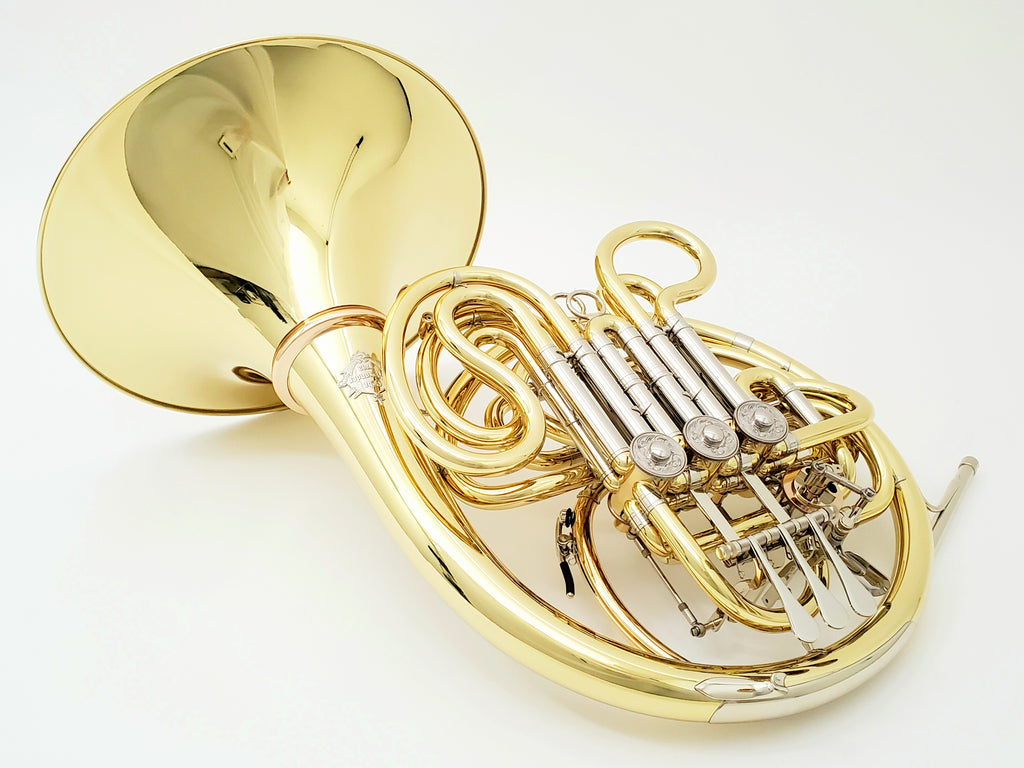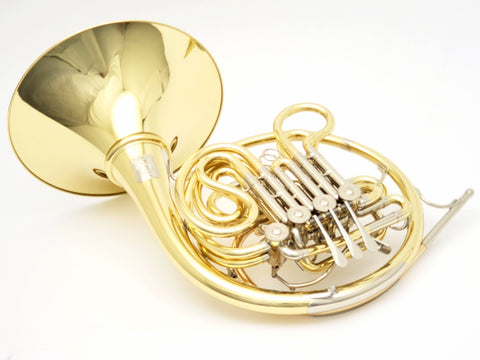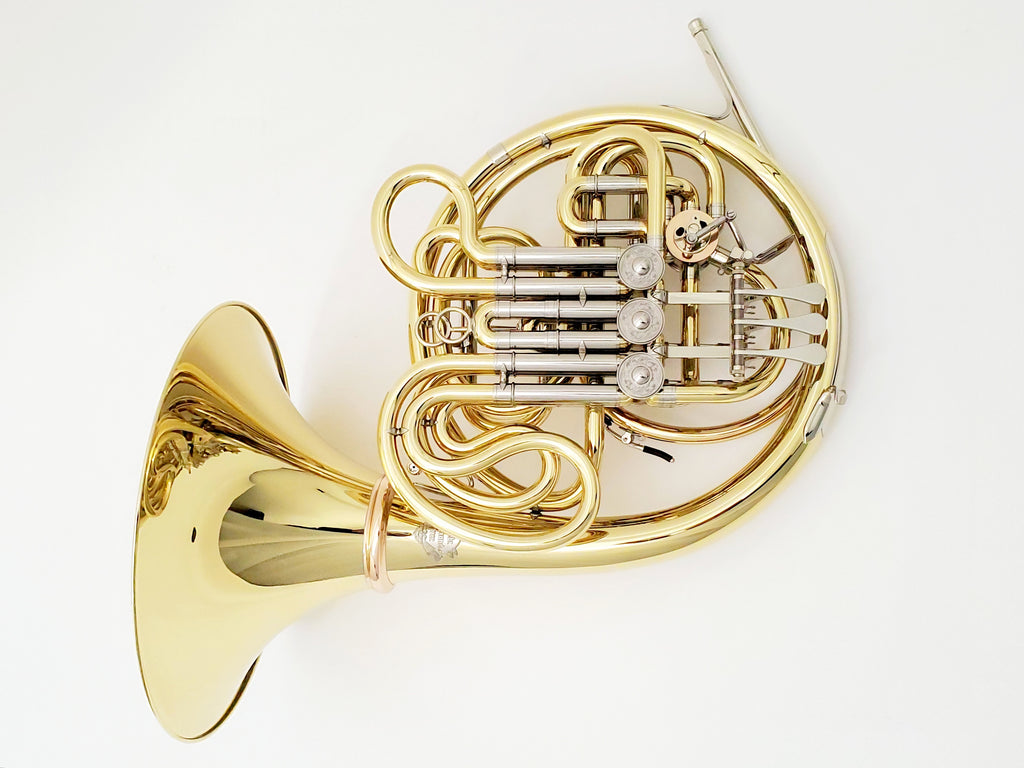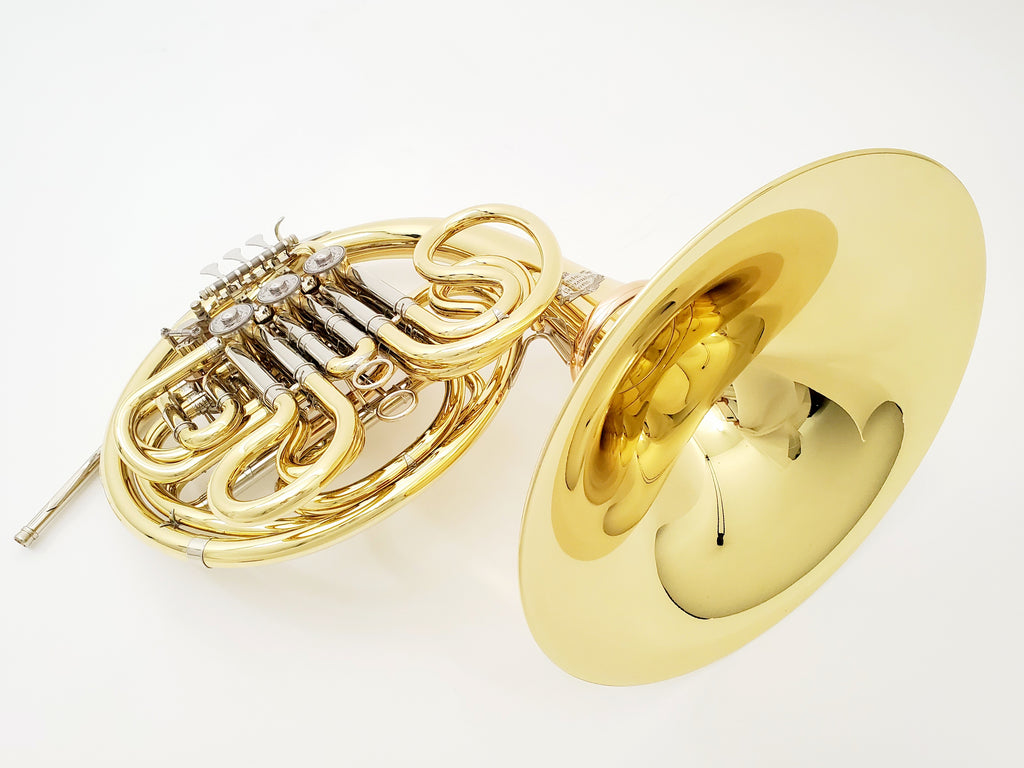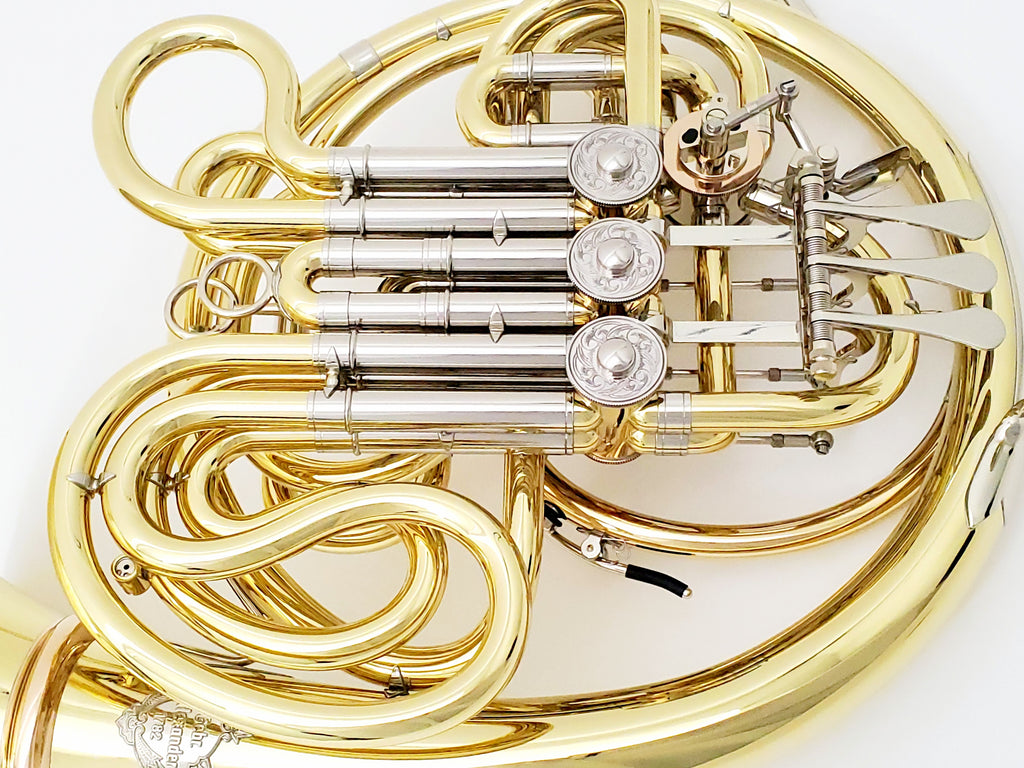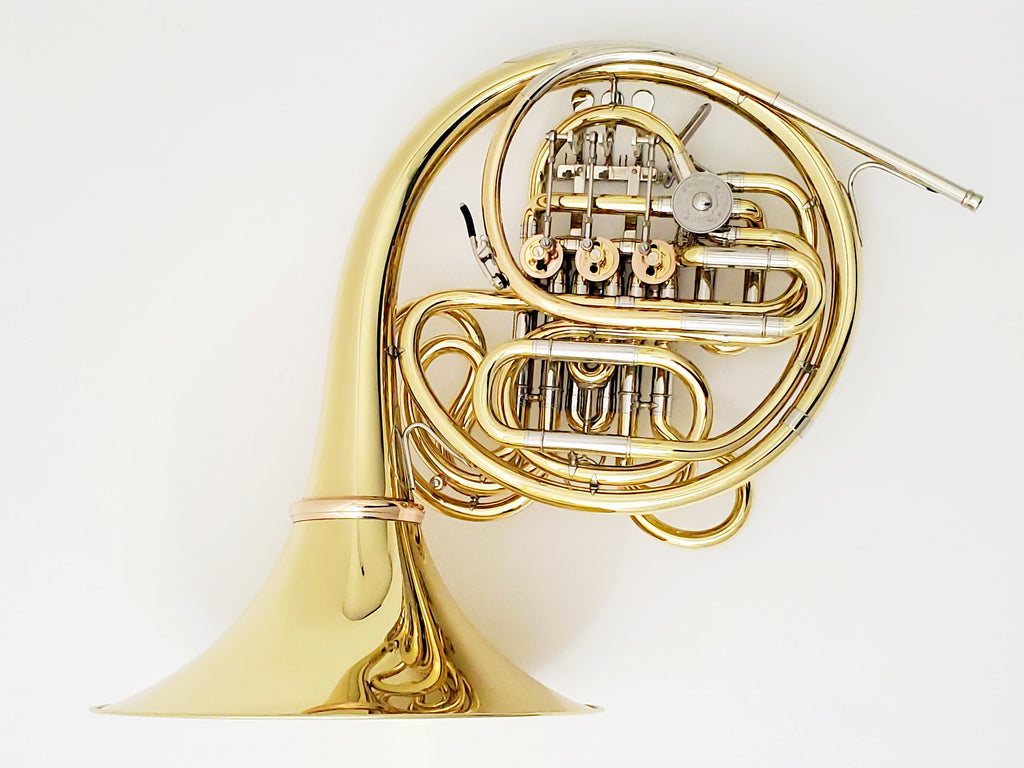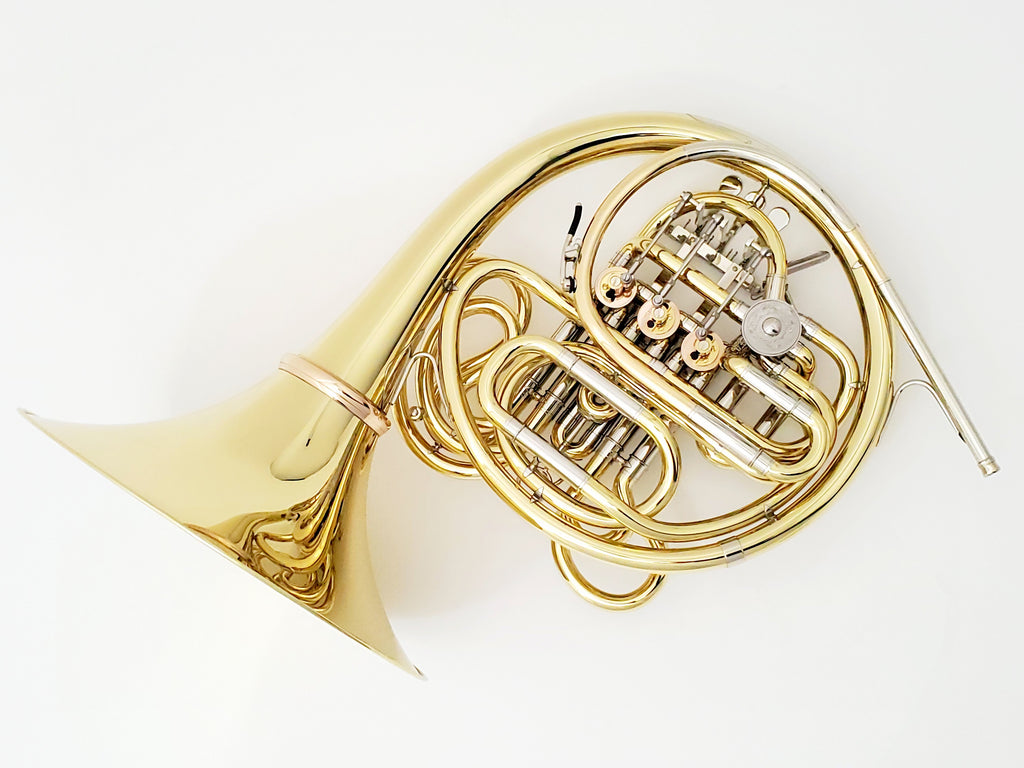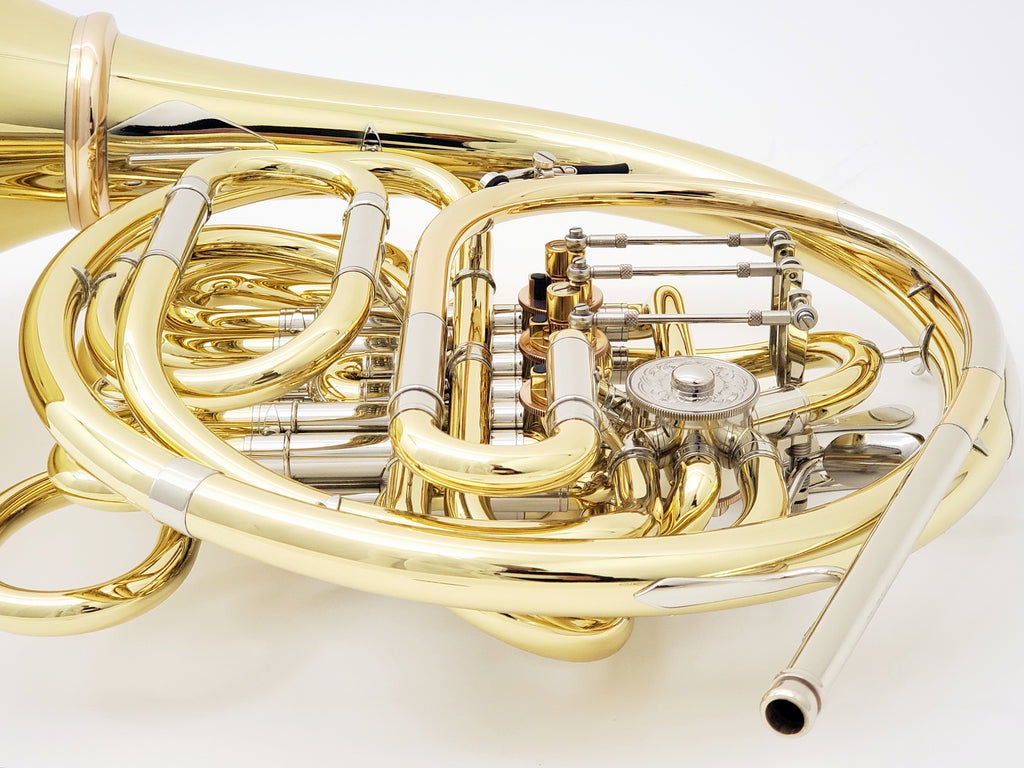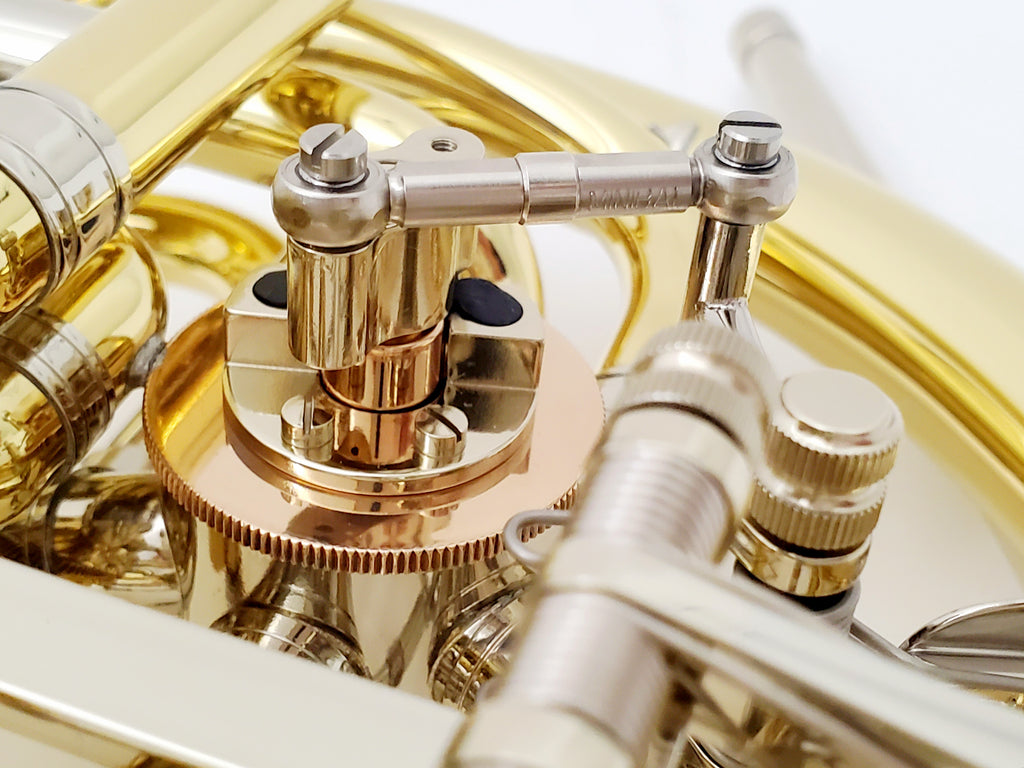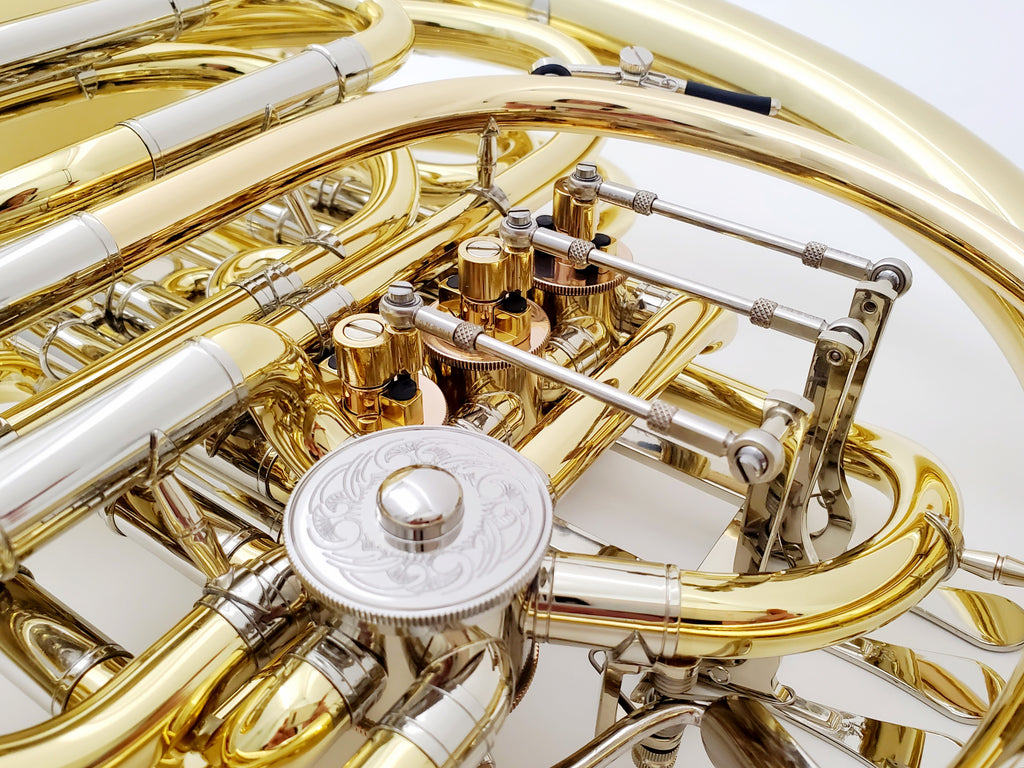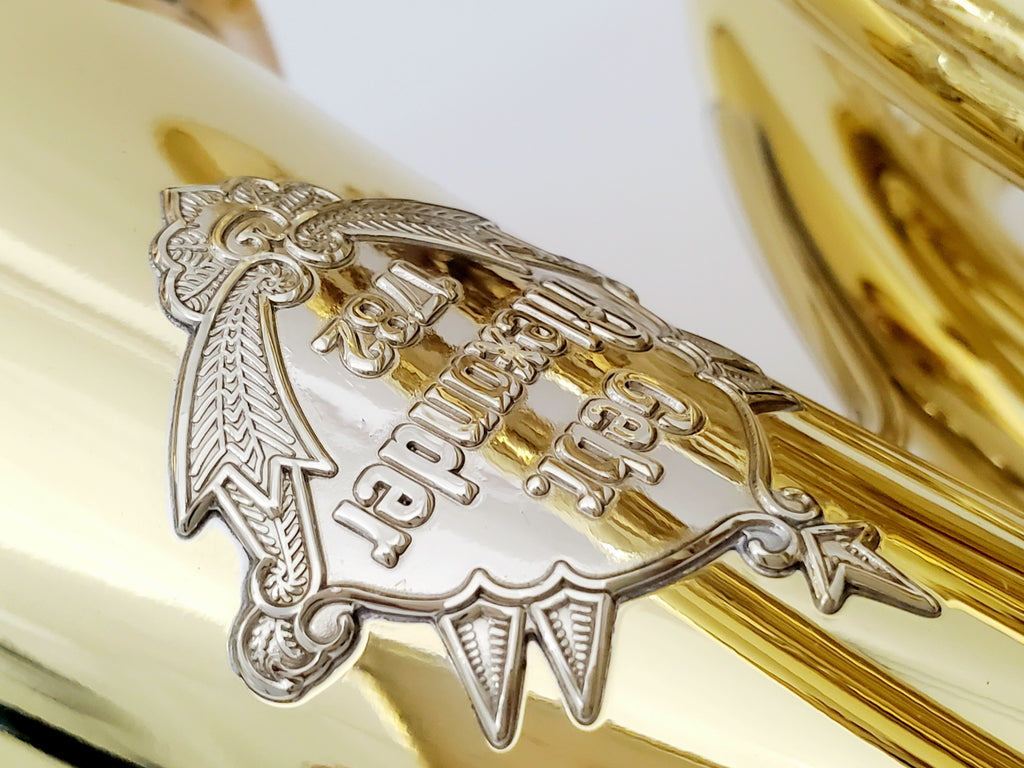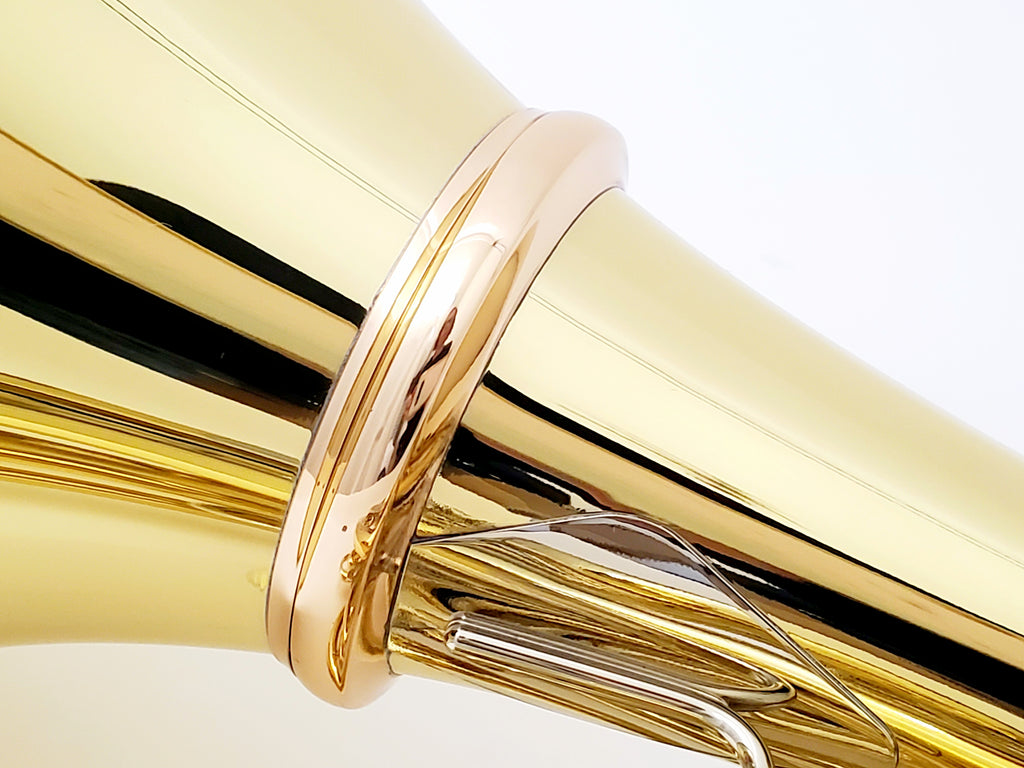Alexander 103 Double Horn
$8,875.00
Item Details
The Alexander 103 is the most popular double horn in all of Europe. In Germany, its sound is ubiquitous in professional orchestras. You'll hear a section of 103 horns in the Berlin Philharmonic as well as many other ensembles. Designed in 1907, the unique change valve of this instrument was patented in 1909. The model 103 tends toward being rather light, with a compact sound and a presence that's more easily heard than from larger and weightier instruments. There's an electricity to the Alexander tone that is not easily found elsewhere. The workmanship is absolutely flawless - this is German craftsmanship at its finest. The change valve only turns 60 degrees, so the thumb action throw is very short. The instrument can be adjusted to stand in Bb or F as you prefer - only a screwdriver is necessary. All rotors are activated by silent Minibal linkages. No restringing will ever be needed, and a small drop of oil will keep the linkages completely silent. The rotors pivot on bronze bushings for long life and silent action.
Hand made in Mainz, Germany in a brand new factory, these Alexander instruments are built to order with many options available. Updated tooling and manufacturing processes have made the current Alexanders to be among the best playing and most consistent ever.
Standard specifications of the model 103:
- 12.1 mm bore (0.480")
- 310 mm bell flare (12.2")
- Medium brass bell and body
- Unique 6-port change valve
- Stands in Bb or F
- Fixed finger hook
- 1 waterkey
- Gold brass mouthpipe, nickel receiver
We stock several styles of 103 double horns
- 1 is the standard setup that most people order...
- Yellow brass body, M bell
- Screw bell flare
- 2 waterkeys
- Fixed finger hook
- Clear lacquer finish
- 2 adds the hand hammered body and seamed flare, and adjustable finger hook...
- Yellow brass hand hammered body, M bell
- Seamed bell flare
- Screw bell flare
- 2 water keys
- Adjustable finger hook
- Clear lacquer finish
- Version 2 is a little lighter, and has more handwork on the body and bell, making the metal a bit more seasoned as well. It's also stronger at the screw flare fitting. This version has a slightly more electric response, more malleable, maybe less stability.
- 3 is fixed bell without lacquer for the least expensive 103 setup by special order.
Waterkeys
The standard waterkey is on the leadpipe. The second is usually an Amado on the third Bb slide.
Hamd Hammered Body
The hammering compacts and hardens the metal slightly, making it more efficient at transferring the airwave. From Alexander:
When we speak of a hand-hammered bell, we are speaking of the bell throat (stem or tail) . This is the part of the bell that is firmly built into the horn body. In hand hammering, after bending and calibrating, the throat is again cast using a bending filler. When the filler has hardened, the entire throat is hammered evenly, which changes the molecular structure of the brass . The filler is then melted out again. Because the melting point of the bending filler is very low, the structure of the brass no longer changes.
The hand-hammered throat has an influence on the response of the horn. In addition, the sound remains “compact” for longer. Consequently, the horn only begins to blare at a louder dynamic.
Seamed Flare
Alexander horns may be had with an optional seamed bell flare, which is made with more hand work and hammering; see the drop down menu for pricing. The hand hammered flare has a more consistent metal thickness. The bell can be made thinner for resonance, but is still thick enough at the screw fitting for durability. The extra hand work required hardens the metal for improved response and projection. That being said, the standard bell is very good, and is less expensive. The difference is the standard bell is made from a disc of sheet brass. The seamed flare is made from a piece of sheet brass more like a letter C, then the ends are closed and soldered, thus the seamed flare begins as a cone shape so its metal thickness remains closer to optimum throughout fabrication.
Accessories
An Alexander mouthpiece, a set of lubricants, and a pencil holder(!) are included. Cases are sold separately. Alexander horns are available with the stock case by request. Because we usually order the Alexanders in a paper bag, you can choose from one of our selection of cases, or no case at all.
Other Custom Options
- Fixed bell
- Fixed finger hook
- Body of gold brass or nickel silver
- Nickel bell garland
- Polished brass, silver or gold plate finish
- Custom engraving
- Right handed operation
- String linkage
- Extra bell flares
Please contact us for a quote if you require anything specific, either a custom 103 or another model from Alexander. Be aware that custom orders of Alexander instruments can take a year to complete. We may be able to substitute your choice of horn for one of our scheduled stock instruments, so please ask.
A short video of a player testing an Alexander horn:
Here are members of the Berlin Philharmonic in a silly question and answer session:
The horn section of the Berlin Philharmonic plays "Freischütz" from their CD "Opera!" (Filmed in Shaky-cam):
Sarah Willis talks with Hans Herrman at Gebr. Alexander in Mainz about how to choose a new instrument:
10 Questions for Berlin Philharmonic horn player Sarah Willis
History of Alexander
In 1782, the musical instrument maker Franz Ambros Alexander arrived in Mainz, the world famous town on the River Rhine, were Johannes Gutenberg had invented the art of printing. Franz Ambros was accepted into the trades guild and he founded a new company for the manufacture of fine musical instruments. Today, more than 220 years later, his company Gebr. Alexander is still owned and directed by the descendants of the founder.
Original manufacturing methods for fine orchestral instruments have been modernized over the centuries. Today, modern technology supports traditional methods wherever this improves the quality of an instrument. All improvements on instruments are due to the daily exchange of Alexander with top professional performers worldwide. Latest scientific research in instrument making is regularly evaluated and introduced into the manufacturing process.
"Tradition and Progress" are the basis for the top position of Alexander-Instruments in worldwide comparison. Thousands of letters of gratitude from all over the world are witness for the satisfaction of Alexander customers. Alexander Horns meet highest expectations. They are used in the best orchestras, in Schools and Universities and by many enthusiastic individuals.
Excellent Materials
When making musical instruments, careful selection of the finest materials is essential. We are using only the very best raw materials, which we obtain from reliable suppliers with whom we have a long standing relation. Our highest demands for exact measurements are always met without exception. As a result, the tolerances of our materials are much smaller than those laid down in the "German Industrial Norm", the DIN norm.
We use three different alloys. Yellow Brass, made from 70% copper and 30% zinc. Its color is yellow with a light green shine in it. Gold Brass, made from 85% copper and 15% zinc has a yellow color with a slight red shine. For mechanically stressed parts such as moving slides, fortifying supports and stays, we use the more robust Nickle-Silver, which is an alloy made of brass and nickle and has a silver appearance. If required, an instrument can be made entirely from Nickle-Silver. Because of the intense demands on the material of the leadpipe due to influences of acidic moisture, this part is only made from durable Gold Brass or Nickle Silver.
Excellent Workmanship
Permanent controls during the manufacturing process warrant perfect dimensions in all tubing. Our master craftsmen personally select the best materials for the production of our instruments and they carefully check the results of each step through which these fine materials pass in the workshops. Each raw product will be manipulated by hand and checked many times during production while an instrument matures to master class. Each Alexander-Horn will go through continuous controls until we can confidently issue a threefold warranty upon completion: for perfect pitch, for easy and balanced response and for best quality materials and workmanship.
Precision Valves
Alexander-French Horns are fitted with conical rotary valves. The valve-casing and rotors are airtight and work precisely and reliable. Treated with care and competence, our valves will function perfectly over a very long period of time.
Easy maintainable and durable Unibal- or Minibal joint mechanisms transfer the pressure from the keys with high accuracy. If required, we offer string action as an alternative.
Proven Design
The bore inside the cylindrical parts of the tubing and inside the valves of all Alexander French Horns is exactly 12.1 mm. The standard dimensions of our instruments are well tried and tested. Exceptions from standards are model 101 with a wider bell and models 99 and 105 with a narrower bell. The standard bell diameter of Alexander French Horns is 310 mm.
Exact measurements are warranted by the calibration of each section of a horn in precise calibration forms.
Each Alexander French Horn can be fitted with a detachable bell if required. The advantage lies in the ease of transport, either in a rectangular case or in a small gig bag, inside which the instrument should be allowed into the cabin of most airliners. We use precision rings to warrant a firm connection between body and bell. Our rings won't open accidentally nor will they rattle during play. Discussions about the influence of detachable bells on sound-quality are ongoing. Many customers have made their decision in favor of the detachable bell and never looked back.
Perfect Finish
All instruments are supplied in high gloss polished finish. Optional lacquering, silver- or even gold plating will protect the surface and, in the case of lacquering and gold plating, will keep the bright shine for a long time. We use a three component epoxy lacquer which has proven for many years to be very durable and flexible at the same time. The durability in silver- and gold plating is warranted by a high quality galvanic process, where generous layers of gold and silver are applied. Discussions about tonal influences of different finishes are ongoing. Any influence could only be minimal. Surface protection will, however, contribute to the splendid appearance and longevity of your instrument.
Perfect Pitch
Alexander Horns are supplied at A=443 Hz when held in standard position (hand in bell). Other pitch is available on application. Best pitch is only warranted when using a normal Alexander horn mouthpiece. All tuning- and valve-slides are made a little shorter than theoretically correct and may have to be pulled out slightly when playing under normal conditions. This allows the instruments to be kept in tune under all external and atmospheric conditions. with most instruments, pressing the first valve will lower for a full tone, the second valve lowers half a tone and the third valve lowers by a minor third. The exception are instruments which are built according to the so called French System, where the third valve ascends for one full tone.
Test Playing
Before any Alexander-Instrument leaves the workshop and enters the sales department, it will be thoroughly test-played by an experienced professional hornplayer. Each single note is checked carefully. Only orchestra musicians or teachers with many years of experience qualify as a test player for Alexander horns. We make sure that each instrument meets the highest expectations of our professional customers worldwide.
Easy, Balanced Response
The introduction of numerous important developments in acoustic research have been instrumental and contribute to the permanent improvement of response in Alexander French Horns. Improved methodology was introduced into the manufacturing process to ensure that perfect measurements remain a constant feature in each of our instruments. When playing our instruments, you will immediately experience the clean separation of tones and feel the well centered sound.
Desired Color of Sound
The basic cause for a particular color of sound in an instrument is the dimension of its bell flare opening. Model 103 has a romantic soft tone, which is slender but carrying at the same time. In model 200, the carrying capacity is increased with a nickel silver garland, which is attached to the rim of the bell. The garland will delay the appearance of "brassiness" during forceful play. Model 1103 offers a brilliant and bright color of sound. If an instrument is fitted with a larger bell, its color of sound darkens. Model 101 is such an instrument. It matches well the sound characteristics of a horn section where wide dimensional instruments dominate.
Some PDFs
Information on Alexander rotors
Information on maintaining your Alexander horn
Who plays an Alexander 103?
by Jeffrey Agrell from Horn Insights (December 2012)
- Andrew Bain – Los Angeles Philharmonic
- Radek Baborak – Berlin Philharmonic
- Sue Baxendale – Scottish Opera
- Timothy Brown – Academy of St Martin in the Fields
- Jörg Brückner – Munich Philharmonic
- Laurence Davies – Royal Philharmonic
- Laurence Dengler – Bavarian State Opera
- Stefan Dohr – Berlin Philharmonic
- Vladimir Dubois – Opera de Paris
- Michal Emanovsky – Seoul Symphony Orchestra
- Luis Garcia – Orquestra Sinfonica Brasileira
- Ivo Gass – Munich Philharmonic
- Juan Gomez – Barcelona Symphony Orchestra
- Ralf Götz – Gewandhausorchester Leipzig
- Volker Grewel – Beethoven Orchester Bonn
- Stefan de Leval Jerzierski – Berlin Philharmonic
- Mahir Kalmik – Frankfurt Symphony Orchestra
- Jacob Keiding – Copenhagen Philharmonic
- Jonathan Kuhns – Hong Kong Sinfonietta
- Robert Langbein – Staatskapelle Dresden
- Markus Maskuniitty – Royal Stockholm Philharmonic
- Fergus McWilliam – Berlin Philharmonic
- William Melton – Aachen Symphony Orchestra
- Reinhold Möller – Bamberg Symphoniker
- Chris Parkes – Swedish Radio Symphony Orchestra
- Andrew Pelletier – Bowling Green University
- Georg Schreckenberger – Berlin Philharmonic
- Jennifer Sholtis – Texas A&M at Kingsville
- Sue Shorland – Band 0f the RAF Regiment
- Jochen Ubbelohde – Dresden Staatskapelle
- Mark Vines – Hong Kong Philharmonic
- Ondrei Vrabec – Czech Philharmonic
- Klaus Wallendorf – Berlin Philharmonic
- Sarah Willis – Berlin Philharmonic
- Hans van der Zanden – Brussels Philharmonic
- Andrej Zust – Berlin Philharmon

